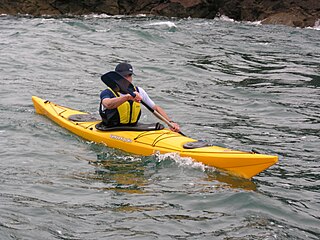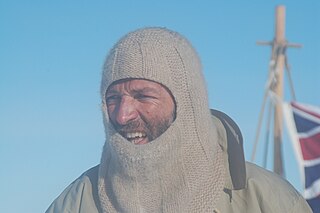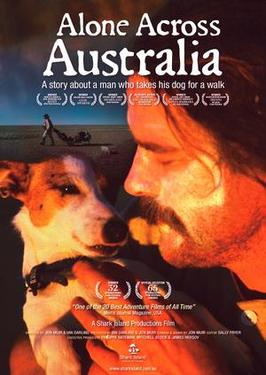
Bass Strait is a strait separating the island state of Tasmania from the Australian mainland. The strait provides the most direct waterway between the Great Australian Bight and the Tasman Sea, and is also the only maritime route into the economically prominent Port Phillip Bay.

The Tasman Sea is a marginal sea of the South Pacific Ocean, situated between Australia and New Zealand. It measures about 2,000 km (1,200 mi) across and about 2,800 km (1,700 mi) from north to south. The sea was named after the Dutch explorer Abel Janszoon Tasman, who in 1642 was the first known person to cross it. British explorer Lieutenant James Cook later extensively navigated the Tasman Sea in the 1770s during his three voyages of exploration.

A sea kayak or touring kayak is a kayak used for the sport of paddling on open waters of lakes, bays, and oceans. Sea kayaks are seaworthy small boats with a covered deck and the ability to incorporate a spray deck. They trade off the manoeuvrability of whitewater kayaks for higher cruising speed, cargo capacity, ease of straight-line paddling (tracking), and comfort for long journeys.

Trans-Tasman is an adjective used primarily to signify the relationship between Australia and New Zealand. The term refers to the Tasman Sea, which lies between the two countries. For example, trans-Tasman commerce refers to commerce between these two countries.

Foreign relations between neighbouring countries Australia and New Zealand, also referred to as Trans-Tasman relations, are extremely close. Both countries share a British colonial heritage as antipodean Dominions and settler colonies, and both are part of the core Anglosphere. New Zealand sent representatives to the constitutional conventions which led to the uniting of the six Australian colonies but opted not to join. In the Boer War and in both world wars, New Zealand soldiers fought alongside Australian soldiers. In recent years the Closer Economic Relations free trade agreement and its predecessors have inspired ever-converging economic integration. Despite some shared similarities, the cultures of Australia and New Zealand also have their own sets of differences and there are sometimes differences of opinion which some have declared as symptomatic of sibling rivalry. This often centres upon sports and in commercio-economic tensions, such as those arising from the failure of Ansett Australia and those engendered by the formerly long-standing Australian ban on New Zealand apple imports.

Timothy John Jarvis is an Australian explorer, climber, author, environmental activist, and documentary filmmaker. He is best known for his numerous Antarctic expeditions, particularly his attempted Antarctic crossing in 1999 and the period recreations of historical treks by Sir Douglas Mawson and Sir Ernest Shackleton.

Alone Across Australia is a fifty-two-minute documentary released in 2003, which is based on adventurer Jon Muir's solo and unsupported journey across Australia in 2001. The motion picture introduces Muir and his exploits all over the world, mainly focusing on his journey throughout the Australian continent, from Porte Augusta in South Australia to Burketown in Queensland.
Andrew McAuley was an Australian mountaineer and sea kayaker. He is presumed to have died following his disappearance at sea while attempting to kayak 1600 km (994 mi) across the Tasman Sea from Australia to New Zealand in February 2007.

Paul Caffyn is a sea kayaker based in Runanga on the West Coast of New Zealand. He has completed a number of supported, unsupported, solo and group expeditions by sea kayak in various locations around the world. He has been described as follows by John Dowd:
Amongst sea kayakers Paul Caffyn is almost in a class of his own. For the longest time after he finished his awesome solo circumnavigation of Australia the silence was deafening: few of his peers knew the significance of what he had done, and perhaps those who understood felt lost in his shadows. Not only is Paul's Australian adventure a pinnacle for sea kayaking, it should eventually be recognized as one of the great small voyages of recent history along with those of Slocum, Shackleton and Franz Romer."

Thirty years after the first person rowed solo across the Tasman Sea in 1977, Crossing the Ditch was the effort of Justin Jones and James Castrission, known as Cas and Jonesy, to become the first to cross the sea and travel from Australia to New Zealand by sea kayak. Setting off from Forster, New South Wales on 13 November 2007 in their custom-designed kayak Lot 41, the two-man expedition succeeded after previous attempts, including the fatal journey of Andrew McAuley, had been unsuccessful. They arrived at Ngamotu Beach, in New Plymouth, New Zealand on 13 January 2008.
A ditch is a small depression created to channel water.
Robert James "Bob" McKerrow, a native of New Zealand, is a humanitarian, mountaineer, polar traveller, writer and poet. He currently works as Country Coordinator for the Swiss Red Cross in the Philippines working on the Typhoon Haiyan (Yolanda) operation. When the Indian Ocean tsunami struck on 26 December 2004, McKerrow worked in India, Sri Lanka, Maldives and Indonesia, coordinating Red Cross programmes for people affected by the tsunami for an eight-year period.

The South Pole, also known as the Geographic South Pole or Terrestrial South Pole, is the southernmost point on Earth and lies antipodally on the opposite side of Earth from the North Pole, at a distance of 20,004 km in all directions. It is one of the two points where Earth's axis of rotation intersects its surface.

Freya Hoffmeister is a German business owner and athlete who holds several sea kayaking endurance records. In 2009 she completed a circumnavigation of Australia solo and unassisted, becoming the first woman and only the second person to do so. Freya holds the fastest record for completing this trip On 3 May 2015, she became the first person to solo circumnavigate the continent of South America.
Adrian Hayes is a British record-breaking polar explorer and adventurer, best known for reaching the three extreme points of the Earth—the Three Poles Challenge—which involved walking all the way to the North Pole, South Pole and summiting Mount Everest, all in the shortest period of time.

Louis-Philippe Loncke is a Belgian explorer, adventurer and motivational speaker. In 2008, he achieved the world first crossing on foot of the length of the Simpson desert, which was a North to South traverse passing through its geographical center. In 2018, he traversed Tasmania during the austral winter without resupplies and was nicknamed the Mad Belgian by some Australians.

Solo is a 2008 documentary film directed by David Michod and Jennifer Peedom. It narrates the story of Australian adventurer Andrew McAuley who attempted a solo kayak crossing from Tasmania to New Zealand.

Oliver "Olly" Hicks is a British ocean rower, kayaker, explorer and inspirational speaker. He holds three world records for adventure. He is best known for his solo ocean rows and extreme kayak voyages. He first made the headlines after his solo trans-Atlantic voyage in 2005 when he became the first and currently only person to row from America to England solo and the youngest person to row any ocean solo. Hicks has rowed and paddled over 7,000 miles on ocean expeditions since 2005. Over 6,000 miles and 220 days alone at sea.
Aleksander Gamme is a Norwegian adventurer, polar explorer, researcher, author and public speaker.













